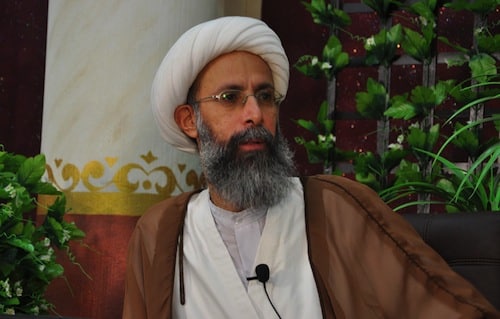The execution of Shi’ite cleric Nimr al-Nimr and 46 convicted al-Qaeda members by the Saudis triggered a still-unfolding crisis between the Kingdom and Iran. Protesters in Tehran set fire to the Saudi embassy, and the Iranian government threatened that the Saudis will face “divine” revenge.
Riyadh responded by severing diplomatic relations and ordering Iran’s ambassador to depart the Kingdom, followed by the cutting off of all commercial ties with Iran. Saudi allies Bahrain, Sudan, and the United Arab Emirates made formal diplomatic protests to Iran. Additional acts of retaliation in a region that embraces the concept will no doubt follow, likely inside the Saudi-Iranian proxy war in Yemen or Syria. There will be blood.
But why execute al-Nimr now?
The cleric has been a vocal critic of Saudi Arabia’s ruling royal family for some years. In 2009 he went as far as threatening Shi’ite secession, provoking a government crackdown in the minority’s eastern heartland. The Saudis have had al-Nimr in custody since 2012, and he was sentenced to death in 2014.
While there are external factors, particularly the broader Saudi-Iranian struggle for power in the Persian Gulf, those are secondary. The execution of al-Nimr was a signal sent by the new King to his supporters and adversaries at home.
The crucial point in understanding any part of Saudi politics is that the Kingdom has not had its Islamic revolution, a transition from a largely secular rule to a theocratic one, as in Iran in 1979 and as is fumbling forward in other nearby locations, such as Syria. Saudi has also not seen the unpredictable upheaval of an Arab Spring. It instead has been ruled by the al-Saud family for decades. The family’s rule has been made possible in part by fundamentalist Sunni Wahhabi clerics, who provide religious legitimacy to the al-Saud family. Alongside all this were a series of strong, patriarchal Saudi kings to keep control of the military and security forces.
Times have changed.
Shi’ite Islam is on the move regionally, perhaps most significantly in Iraq. Following the American invasion of 2003, Iraq changed from a secular regime under Saddam that waged open war against Shi’ite Iran, to the largely Shi’ite regime now in power in Baghdad that openly welcomes Iranian special forces. Saudi Arabia’s steadiest partner, the United States, has become prone to erratic acts, naively bumbling into Iraq in 2003, demanding regime changes here and there, and unofficially partnering with the Iranians to defeat Islamic State.
The US is also far more energy independent than a decade ago and is slowly moving toward some form of new diplomatic relationship with Iran. Oil prices have also been falling. Many disgruntled Saudi Sunnis support Islamic State, an organization that has sworn to take down the al-Saud monarchy. These are all potentially destabilizing factors for the Saudis.
But perhaps most significantly, the al-Saud family’s rule is facing succession issues in the form of the deceased King Salman’s newly empowered 30-year-old son, Mohammed bin Salman. It is the first time since the country’s modern founder, King Abdulaziz, died in 1953 that power has been concentrated in the hands of just one branch of the family. This was done by the deceased King’s decision to bypass one of his brothers, the traditional successor, in favor of a nephew, who has set up his son as successor. There have been thus not surprisingly rumors of opposition to the son, even of a coup.
It was also the son, who, as defense minister, oversaw the decision to go to war in Yemen, launching his country into an open-ended struggle he may sometime face the need to defend.
The execution of al-Nimr sends multiple signals. The most significant is a get-tough message to all inside the Kingdom, coupled with an assurance to the Iranians that Salman is firmly in charge and able to further prosecute the war in Yemen. The execution appeases the Wahhabists, and gives the government a chance to crackdown on Shi’ite dissent.
Al-Nimr’s crime was described using terms normally reserved for jihadist groups such as al-Qaeda and Islamic State, to include plotting to overthrow the Saudi government. In a region that pays particular attention to symbolism, executing al-Nimr as a terrorist, alongside 46 al-Qaeda members, is a crystalline example of how the Saudi authorities view a man seen by many Shi’ites inside the Kingdom as a freedom fighter of sorts, and as a religious figure in the greater the Shi’ite world.
And in case anyone still did not get the message, the Saudi government did not give al-Nimr’s body to his family, saying that they already buried all of the corpses.
The burning of the Saudi embassy in Tehran plays right into this, though it was unlikely to have been anticipated. But what better way to wag the dog for the war in Yemen and perhaps beyond than another example of the “out of control” Iranians, and the threat Shi’ites pose. It doesn’t hurt Saudi relations vis-a-vis the United States to see an embassy burn once again in the heart of Tehran, or for local Saudis angered by a 40 percent rise in gas prices to have an external enemy to distract them.
Events set in motion are difficult to control, and things may yet spin out of Salman’s control, and the ploy backfire; for example, al-Nimr is now a martyr with an international profile.
But for the time being, it appears Salman has moved ahead a few spaces in a real-life Game of Thrones.
Reprinted with permission from WeMeantWell.com.


